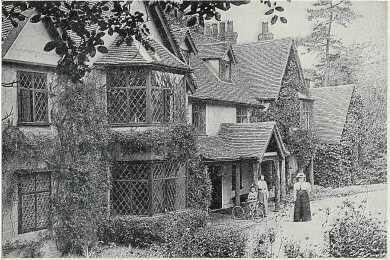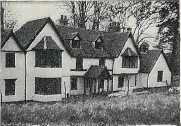
The Old Rectory at Great
Yeldham, photographed in 1899. It was built in the late fifteenth
century but has Victorian additions, including the timbered
porch.
SOFT-WATER WELL
To the right of the hall is a
breakfast room, one of the flagstones of which can be raised to reveal a
soft-water well. During our first year of residence my wife and I
frequently ate our meals to the accompaniment of the croaking of frogs
that made their way out of this well and across the floor. Beyond the
breakfast room lies the kitchen, which at one time was a brewhouse. Ham
hooks adorn the ceiling and the roof above boasts a belfry, whose bell can
be tolled from the kitchen quarters below. A main stairway from the lower
passage beyond the hall leads up to a room on the first floor which has an
exceptionally beautiful carved oak ceiling of the sixteenth century. This
ceiling is decorated with heraldic emblems and symbols of a masonic
character and may have been built into the house at a slightly later
period than the original structure. Nearby, in the wall of the upstairs
passage, the exposure of beams has revealed the framework of
Elizabethan windows, covered in when the house was extended at a later
date.
THE
HOUSE
OF SECRETS
Four years ago, in search of a
home which would enable my wife and me to sink our roots in the fertile
soil of north Essex, I wandered down a leaf-strewn drive to find myself
confronted by a building of truly enchanting features. The enchantment
prevailed over a natural reticence at the very obvious drawbacks, and
I became the owner of a house that must surely be one of the most unusual
in Essex.
Several years ago our author
became the owner of a very old and most unusual Essex house. In the
breakfast room a flagstone can be raised to reveal a soft-water well; from
the kitchen a bell can be tolled; and throughout the house a wealth of
inscriptions adorn the many beams. What is more, a set of old human bones
was found under a window-seat—and on a number of occasions the front-door
bell has rung without visible cause!
One of the most fascinating
features of the house from an antiquarian standpoint is the wealth of
inscriptions upon beams to be seen in various parts of the building.
Crossbeams in a small room on the first floor contain Greek and
Hebrew lettering of early origin. In one of the three attic rooms is
another beam which contains an inscription in early English lettering: "
Cast me not away from thy presence"—a
quotation from the psalms.
A SECRET PASSAGE?
As one might expect, there is a
cellar beneath the house on the south side. The doorway to the cellar is
fifteenth-century. For many years there has been talk of a priest's hiding
place and a secret passage from the cellar to the nearby church. Alas, so
far we have failed to negotiate either. Perhaps further searching will
reveal both.
Each era of its history has left
its mark upon the Old Rectory: the Tudor lath and plaster and brickwork,
the Elizabethan windows, the seventeenth-century gables, the Georgian
panelling and the large Victorian wing at the south-western end of
the house. The fine array of chimney-stacks also reflects the passage of
history.
STRANGE HAPPENINGS
An article of this nature would
hardly be complete without a reference to ghosts, for Essex is a county
famous for its ghoulish manifestations. Shortly after moving in we heard
stories of Edwardian maidservants
RETAINS ITS SECRETS
The Old Rectory at Great Yeldham
was built as a parsonage in the late fifteenth century and nestles in a
dell behind the parish church of St. Andrew. It is a long, rambling house,
the medieval part of which is of lath and plaster while the inevitable
Victorian addition is of brick with a plaster surface. The visitor passes
under a pleasant timbered Victorian porch and enters a fine hall with
stout oak beams in the ceiling and a floor of early tiling. Adjoining the
hall on the left-hand side is a room with moulded ceiling timbers and a
decorated central beam. It also has a large Tudor fireplace which was
recently exposed. It was under the window-seat of this room that we made
the surprising discovery of a set of human bones. Subsequent tests
revealed that these were the bones of a woman and were somewhere between
300 and 400 years old. One is free to speculate on the possibility of a
plague victim. Equally it may be that the cemetery was at one time greater
in extent than today. Perhaps even darker visions come to
mind.
by Ronald Bartle
One will never know the answer.
This house, like many others, retains its secrets.
The room just mentioned leads on
into a smaller room known as the prayer room, where no doubt generations
of clergymen held family prayers and probably also practised their
private devotions. Its somewhat obviously Victorian Gothic doorway is
encased in an earlier medieval structure with drawings of apparently
very early origin on the upright supports on either
side.
